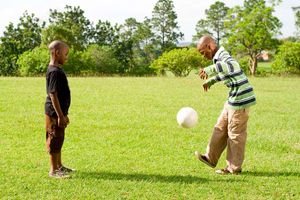What to know about Down Syndrome and how to help your child live a healthy, normal life

What you need to know:
- Down Syndrome occurs when a child has an extra copy of chromosome 21, or Trisomy 21.
- There is no specific treatment for children with Down Syndrome. However, parents can ensure that their children continue to live as normally as possible.
- The abilities and challenges of children with Down Syndrome will vary.
When Maureen Achieng’s baby was born, his head and ears were too small, he had a short neck and a bulging tongue. The head was also flat at the back. Over the next few months, the unique facial and physical features became more prominent. “His ears became more atypically shaped, he had a poor muscle tone, and the inner corner of his eyes was rounded instead of pointed,” she says. Between age three and age five, her son developed gastrointestinal problems. Maureen shuttled from one hospital to another in search of a diagnosis. She was afraid that her son was born with a form of mental challenge. Eventually, her baby was diagnosed with Down Syndrome at a private hospital in Nairobi.
Maureen’s son is one of many kids suffering from Down Syndrome. These children tend to develop slowly compared to other babies without the condition. According to the Centre for Disease Control, babies with this condition will also have small hands and feet, a single line across the palm of the hand known as palmar crease will be shorter in height both as kids and adults, and have small pinky fingers that sometimes curve towards the thumb.
What is it?
According to pediatrician Stephen Muhuthia, Down Syndrome occurs when a child has an extra copy of chromosome 21, or Trisomy 21. “Persons with Down Syndrome usually have 47 chromosomes instead of the normal 46,” he says. The extra chromosome causes difficulties in body and brain development.
Defects range from severe to mild. The abilities and challenges of children with Down Syndrome will vary. Some children will have poor judgment, others will have slow learning capabilities, while some will have a tendency for impulsive behaviour, and others will have short attention spans. However, amongst all children, the measure of intelligence which is also known as IQ will be mild to moderately low. This is why children with this condition take longer to speak.
According to the CDC, there are three main types of Down Syndrome.
- Trisomy 21: This accounts for about 95 percent of all cases of Down Syndrome. With this type, each cell in the body has 3 separate copies of chromosome 21 instead of the usual 2 copies.
- Translocation Down syndrome: This accounts for about 3 percent of all the cases of Down Syndrome. This type occurs when an extra part or a whole extra chromosome 21 is present, but it is attached or “trans-located” to a different chromosome rather than being a separate chromosome 21.
- Mosaic Down syndrome: This accounts for about 2 percent of all cases of Down Syndrome. Children who get this type usually have a combination of about three faulty characteristics. For example, some of the kids’ cells have 3 copies of chromosome 21, but other cells have the typical two copies of chromosome 21. This type is easier to live with because whereas children may have the same features as other kids with Down Syndrome, these features will be fewer and less impacting. This is due to the presence of many cells with a typical number of chromosomes.
Obese children with Down Syndrome are likely to have breathing problems and gastrointestinal complications. Their ‘breathing pipes’ tend to be thin and clogged. The CDC recommends that these kids should have plenty of exercises and a balanced diet. “High-calorie foods do not make it any easier for the child to cope,” says Muhuthia.
Kids with Down Syndrome also frequently have dental problems. Their teeth may be wrongly shaped or aligned, such that they are likely to injure the tongue during eating.
Treatment
Dr. Muhuthia says that there is no specific treatment for children with Down Syndrome. However, parents can ensure that their children continue to live as normally as possible. To begin with, children with gastrointestinal problems may need major surgeries soon after birth. “If it is suspected that the child has Down Syndrome, it is important for an echocardiogram test to be done, to check any heart defects soon after birth,” he says. In addition, where this condition has been suspected or diagnosed, the child will need to undergo multiple tests as he or she grows. For example, the child might need to go for an eye test once every year, and regular occupational therapy. If your child has dental problems, it is critical that she has dental examinations every 6 months. In the same breath, if she is between age 3 and 5, take care to have her upper or cervical spine examined. An X-Ray test for the chest and gastrointestinal tract is important. Dr. Muhuthia also says that heart infections such as endocarditis are very common in children with Down Syndrome. These can be prevented or treated by using clinically prescribed antibiotics.
Children with defects resulting from Down Syndrome are likely to suffer from frustration, anger, social stigma, and depression. In addition, they are likely to have bouts of behavioural deficiencies. Learn and make a habit of reaffirming your child.
“Although your child is special in a way, he or she should not be made to feel odd, different, or disadvantaged. You should also not make a habit of telling your child not to worry because for their disability they are doing well,” says Dr. Muhuthia. Where Down Syndrome has been discovered at an early age, the baby should be taken through rehabilitative, professional therapy. This includes physical, speech, and occupational therapy, both from home and at school.
Quick takeaway:
Women who get pregnant above the age of 35 years are at an increased risk of having kids with Down Syndrome. The number of births of children with Down Syndrome is higher among women below the age of 35 because the rate of women who give birth is overwhelmingly higher among younger women than older women.
Other common Down Syndrome signs:
- Separated joints between the bones of the skull also known as sutures.
- Decreased muscle tone at birth.
- Delayed mental and social development. These may include impulsivity, short attention span, slow hearing, and poor judgment.
- Chronic constipation and severe vomiting.
- Ear and eye infections.
- Obstructive sleep apnea.


